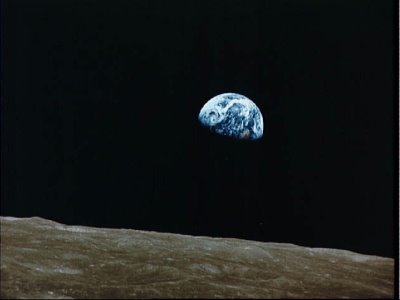Forty-one years ago this Christmas the first human space flight left the Earth’s orbit: the three-man crew of that mission became the first humans to directly see the “dark side” of the Moon. And they were the first humans to see the planet Earth from beyond low Earth orbit [1]. I was a teenager during that tumultuous year: 1968 had seen the Tet offensive in Vietnam, the assassinations of Martin Luther King, Jr. and Robert F. Kennedy, the Soviet invasion of Czechoslovakia, riots in America’s ghettos and at the Chicago Democratic National Convention, the massacre at My Lai. This lunar exploration was probably the brightest, most optimistic news of that frightening and chaotic year. The excitement of the historic Christmas was somewhat dimmed for me by the knowledge that in the new year the young man who was my first boyfriend would be drafted into the military.
Despite being a young person feeling overwhelmed by events in my life and in the world, the photograph that came to be known as “Earthrise” deeply touched me that season as it did so many others, and helped me sustain some feelings of hope. That picture, take by the crew of Apollo 8, was of our planet Earth in the darkness “like a Christmas tree ornament lit up in space, fragile-looking…” It may seem incredible to those who are too young to remember that before those days in December no one had ever before seen the Earth in this way.
That photograph of the Earth rising over the horizon of the Moon has, according to one news source, “become one of the most reproduced and recognized pictures of our planet.” After the lunar mission “Life” magazine called the image one of the “100 photos that changed the world.” Astronaut Bill Anders said, “After all the training and studying we’d done as pilots and engineers to get to the Moon safely and get back, [and] as human beings to explore Moon orbit, what we really discovered was the planet Earth.”
I can only liken the experience of seeing those images for the first time to living your entire life without ever having the ability to step outside to view the exterior of your home. You feel sure you know what the house looks like, but you function every day without ever really giving much consideration to where you are living. And then one day a stranger approaches, opens the door, guides you into the dazzling sunlight, and says, “Here is the place where you live.”
Apollo 8 was the first time humans had ever orbited the Moon. The craft circled the Moon ten times over the course of 20 hours. On Christmas Eve 1968, during the ninth orbit, the astronauts read passages from the Old Testament Book of Genesis during a telecast that featured their live transmission of images of Earth. It is estimated that about 2 billion people–approximately half the Earth’s population that year–watched and listened. The Apollo’s crew began their journey home to Earth on Christmas Day.
On Christmas Eve last year, while reading a tribute to Apollo 8 on the Fox News website, I found a link to the audio recording from that other Christmas Eve forty one years ago. Everything in my life has changed since 1968. But I was filled once again with so many of the same emotions as on that night in my youth when, from our black and white television, I heard the reassuring voice of Commander Frank Borman conclude the broadcast of the Genesis reading with: “Good night, good luck, a Merry Christmas — and God bless all of you, all of you on the good Earth.”
CAJ note: this article has been corrected and footnoted.








